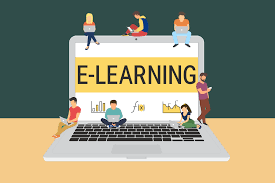The availability of modern technologies has made creating an eLearning program less daunting. But it takes a lot of planning and study to create a custom eLearning development program that actively engages the learner, stimulates the brain, and improves retention.
According to a study, by 2022, the global eLearning market is expected to be worth 243 billion dollars. This is an obvious example of how technology changes how individuals acquire knowledge and skills. Anyone can now learn new things from the convenience of their home, including languages and skills. Through online classes, teachers and students can communicate. Businesses can provide their staff with global training.
There are many chances for designers and developers because of the desire for eLearning platforms. In order to fully satisfy the needs of learners, a good customized eLearning program is essential. It also raises performance levels and aids in closing knowledge and skill gaps.
Here are 9 essential guidelines to remember for effective, outcome-driven custom eLearning development services;
- Get The Goals Sorted
Let’s start with your program’s goal, which should be its focal point. It’s simple to become mired in a single course while developing an eLearning program, but it’s crucial that businesses have a larger objective in mind. Knowing your overarching objective will enable you to direct your eLearning and assess your efforts’ effectiveness, which will ultimately save you time and money. Whether integrating new hires in less than 4 weeks or providing an annual training program to 10,000 employees, whatever your goal, be sure you know it before you begin your training.
- Building New eLearning Strategies
If you do not have a pre-planned course, you risk creating a useless one. Additionally, learners may not be engaged in your course because they see it as a waste of time. Therefore, you need a plan that outlines the educational objectives, establishes the instructional methodology, creates the activities that support the learning goals, and establishes the delivery method. You can identify design problems, identify knowledge gaps, and incorporate vulnerabilities and structural inconsistencies that might otherwise harm your eLearning course by using a well-documented eLearning strategy, which functions as a roadmap.
- Blend it up
The blended learning model can potentially improve training within your company. In its simplest form, blended learning is the fusion of conventional face-to-face instruction and technology-based eLearning. Offering multimedia information to students between and during class sessions, completing online tasks, using post-course questionnaires, or doing whatever else you wish are all effective ways to incorporate it into your eLearning approach. Everything depends on your organization and how it functions best for you.
- Selecting The Right Communication Means
The best option will mostly depend on the particulars of the intended audience, aims, educational practices, and underlying concepts of the platform.
With easy video learning for adults with cognition and memory impairments, you can concentrate on one form of content, or you can combine many techniques. In either case, this decision will influence the user interface and experience of the eLearning system, as well as the selection of tools and third-party integrations.
- Automated Rewards For Course Completions
Give certificates as prizes to your students after they finish their courses. When a course is completed, it can be configured to create automatically. Additionally, they may be utilized for training sessions that must be updated annually or semi-regularly. Certificates provide your students with enjoyment, a sense of achievement, and motivation in a manner akin to gamification. Additionally, you can customize them by using our templates.
- Setting Schedules
By making a thorough timetable, you can make sure you’re well-organized, hitting your goals, and providing training effectively. It will be easier to build courses, prioritize work, and make doable to-do lists for any and all instructional stakeholders if you have a general timeline. The start, end, and other important dates for the projects should be included in your eLearning timetable. Ensure that everyone is on the same page and that you can reach your deadlines, including important dates for designers, managers, and course creators.
- The Distraction-Free Templates
The decoration is not necessarily necessary for effective design. The pages can be kept clutter-free and spotless. After the preliminary concept, you must remove unnecessary images, embellishments, and text because these excess features just serve to confuse the student and serve as a distraction. The best eLearning templates motivate you to concentrate on the course material. Choose a distraction-free template that leads students through the course result.
- Developing New Content By Using Old Content’s Analyses
Take a quick tour of your material library before diving right into a new course. The numerous modules, presentations, video tutorials, and job aids you have created over the years may already contain everything you require. Make a content inventory if you don’t already have one.
Make sure you can quickly identify the stuff using the inventory’s various characteristics. Therefore, use the terms carefully. Additionally, the inventory must include details that make it simpler to spot information updates and content shortages. As a result, you might want to consider data gathering as it is given in the series’ covered subjects.
Develop Clutter-free Content
We’re all guilty of stuffing classes full of everything in a bid to get students interested. However, it’s not always the greatest option. A learner may become confused and overwhelmed by too much media. Try to limit the number of effective media pieces you use per module to one or two. Reduce the number of images as well; you don’t want to divert students’ attention from your main point.
Conclusion
Finally, remember that progress is always a work in progress. There is new authoring software to learn, cutting-edge technology to use, a different approach to master, and a new writing style to adopt. We anticipate that the advice above will help you create a custom eLearning development program that soars to new heights.




